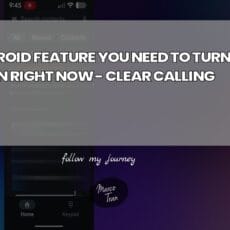Windows 11’s Phone Link experience brings your mobile life into your desktop world. For many, it’s a revelation: messages, calls, notifications, photos, and even media controls are suddenly available where you do most of your work. But not everyone wants this information front and centre, especially in the Start menu. Whether you’d prefer a cleaner look or you simply want to toggle the feature on and off depending on your day, Windows 11 makes it easy to remove or add the Phone Link panel in Start. In this guide, we’ll walk through the exact steps shown in the video, then expand with practical tips, optional configurations, setup advice, and troubleshooting so you can make Phone Link work for you.
We’ll go beyond a simple summary. You’ll learn what Phone Link does, why you might want it visible or hidden, how to customise its behaviour, and how to set it up properly on both Android and iPhone (with notes on the differences). By the end, you’ll be able to tailor your Start menu and your cross‑device experience to suit your workflow.

The Phone Link Panel in the Start Menu
Windows 11 offers a compact panel on the side of the Start menu that summarises your connected mobile device. When enabled, you’ll see quick actions and status indicators for your phone—things like recent notifications, messaging shortcuts, and media controls. It’s designed to be glanceable, saving you from picking up your phone while you’re at your PC. If you’re in the middle of a document and a notification arrives, you can check it without breaking your flow. If you’re enjoying music on your phone and need to pause or skip quickly, it’s right there.
For some, this panel is indispensable. For others, especially if you prefer a minimalist Start menu or you don’t use Phone Link often, it can feel like clutter. The good news is you don’t have to live with it if it’s not for you—there’s a one‑click toggle to hide it, and it’s just as easy to bring it back later when you want it.
What Is Phone Link, and Why Use It?
Phone Link is Microsoft’s bridge between Windows 11 and your smartphone. Originally focused on Android, it now includes limited iPhone support as well. The idea is simple: keep your attention on your PC, but don’t lose access to what matters on your phone.

On Android, Phone Link is particularly robust. Once connected, you can:
- Receive and manage notifications from your phone directly on your PC.
- Read and send SMS and MMS messages from the desktop, with a proper keyboard.
- Place and receive phone calls using your PC’s speakers and microphone.
- Browse and quickly transfer recent photos from your phone to your PC.
- Control media playing on your phone—pause, resume, skip tracks, and sometimes manage volume, depending on the app.
- Open and interact with certain Android apps on your PC (availability varies by device and manufacturer).
- Use advanced features like cross‑device copy and paste or, on supported devices, use your phone as a webcam in Windows 11.
On iPhone, support is more restrained due to platform limitations. You can typically view notifications, place and receive calls, and send and receive basic messages via Bluetooth. However, media sharing, photo browsing, group messages, and image attachments are restricted, and conversation history is limited. If you’re an iPhone user, think of Phone Link as a handy desktop extension for fundamental communication, rather than a full mirror of your phone.
Practical Example: Media Controls, Messages, and Photos
A common scenario is music playback. Perhaps Spotify is running on your phone because you’re moving around during the day, then you return to your desk and want quick control without hunting for your handset. With the Phone Link panel active in Start, you can hit play or pause from your PC, and get on with your work.

Similarly, messages are easier to manage with a physical keyboard. If a text arrives and you want to respond with more than a few words, typing at your PC is faster and more accurate. Photos are another time‑saver: you can drag recent images straight into an email or document without emailing them to yourself.
It’s not just convenience, though. There’s a focus angle too: when your phone’s life is surfaced in Windows, you aren’t constantly reaching for it. That can reduce distractions and keep your workflow cohesive. Of course, not everyone wants that in Start. If your phone is solely for personal content or you manage sensitive information, you might prefer to hide the panel and keep the experience inside the full Phone Link app only.
How to Remove the Phone Link Panel from the Start Menu
Ready to tidy up your Start menu? Hiding the Phone Link panel is straightforward and reversible. Follow these steps:
- Open the Start menu in Windows 11.
- Click the More button (the ellipsis) within the Start menu interface to access extra options.
- Select Start settings. This opens the customisation panel specifically for Start.
- Find the option labelled Show mobile device in Start.
- Turn this option off to hide the Phone Link panel from your Start menu.
- Press the Start button again to verify that the right‑hand Phone Link options have disappeared.

If you’d rather navigate via the Settings app, you can reach the same toggle here:
- Open Settings.
- Go to Personalisation.
- Choose Start.
- Toggle Show mobile device in Start to Off.
This setting is purely a visual preference. It hides the panel but doesn’t sign you out of Phone Link and doesn’t uninstall anything. You can still open the Phone Link app when you want the full experience; it’s simply not displayed in Start.
How to Add the Phone Link Panel Back Again
Decided you miss having your phone’s presence in Start? Re‑enable it in just a moment:

Use either of the methods below:
- From Start: Open Start > More (ellipsis) > Start settings > toggle Show mobile device in Start to On.
- From Settings: Open Settings > Personalisation > Start > toggle Show mobile device in Start to On.
Once you turn it back on, press the Start button and the right‑hand Phone Link panel should reappear. If it doesn’t, check that your phone is connected in the Phone Link app and that you’ve granted the necessary permissions on your mobile device (for notifications, messages, and media access). Sometimes the panel waits for the app to confirm a live link before showing detailed content.
Customising Your Phone Link Experience
Whether you keep the Start panel visible or not, Phone Link offers several customisation options to tailor the experience to your preferences and privacy requirements.
Notification Management
You can choose which apps deliver notifications to your PC. If you’d rather not be pinged by social media during work, disable those but keep messaging and calendar alerts. Within the Phone Link app on your PC and in the Link to Windows app on your phone, you’ll find controls for app‑specific permissions.
Messages and Calls
On Android, messages and calls are well integrated. You can compose texts quickly, see threads, and handle calls with your PC’s headset. On iPhone, calls work, but messaging is limited—group messages and media aren’t supported, and you won’t see full histories. Decide whether you want calls ringing on your PC or keep them limited to your phone; either is fine, and it’s easy to toggle.
Photos and Media
Android users can browse recent photos and drag them into documents and emails. Media controls are designed for quick actions: play, pause, skip, and basic volume changes depending on the app. This is especially useful if your phone is the main music player in the room and you don’t want to disturb your flow just to reach for the device.
Privacy and Permissions
Phone Link requests permissions on your phone during setup. You can revise these later. If you’re working with sensitive content, consider limiting notifications or disabling message previews on your PC. Think of it like desktop‑friendly boundaries: give the PC access to what you want and hold back what you don’t.
Setting Up Phone Link Properly
If you’ve never used Phone Link and want to give it a go, setup is straightforward but worth doing carefully. A good setup means fewer hiccups and a smoother day‑to‑day experience.
Requirements
-
- A Windows 11 PC with the Phone Link app installed (it comes preinstalled on most PCs; otherwise, download it from the Microsoft Store).
- On Android: the Link to Windows app (often preinstalled on Samsung devices) or available via Google Play. Sign in with the same Microsoft account you use on your PC.
- On iPhone: Phone Link supports calls, basic messaging, and notifications via Bluetooth. You’ll pair the device and grant access via the iOS Bluetooth and notification settings.
- Wi‑Fi and Bluetooth enabled on both devices. Keeping both devices on the same network helps ensure reliable connectivity.

- Permissions granted during setup: notifications, contacts, messages, photos (as desired).
Android Setup Steps
- Open Phone Link on your Windows 11 PC.
- On your Android phone, open Link to Windows and sign in with the same Microsoft account as your PC.
- Follow the on‑screen pairing steps. You’ll likely scan a QR code from the PC using your phone.
- Grant permissions as prompted: notifications, contacts, messages, and photos if you want photo access.
- Once connected, test notifications, messages, and media controls from the PC.
- Optionally customise app notifications and privacy preferences in both the Phone Link app and Link to Windows.
iPhone Setup Steps (Limited Support)
- Open Phone Link on your PC.
- Enable Bluetooth on both the PC and the iPhone.
- Follow pairing instructions to connect the iPhone to your PC via Bluetooth.
- Grant permissions for notifications and calling. Messaging is basic and does not support group chats or media attachments.
- Test calls and notifications. Adjust notification visibility to suit your privacy.
Troubleshooting: If the Panel Doesn’t Appear or the Option Is Missing
Occasionally, you might not see the Show mobile device in Start toggle, or the panel may remain empty. Try the following:
Update Windows and Phone Link
- Ensure Windows 11 is fully up to date (Settings > Windows Update > Check for updates).
- Update the Phone Link app via the Microsoft Store.
- On Android, update the Link to Windows app via Google Play.
Confirm Permissions
- On Android, open Link to Windows and confirm that notifications, messages, calls, and photos (if desired) are granted.
- On iPhone, confirm Bluetooth pairing and notification permissions.
Reconnect Your Devices
- Sign out and back into the Phone Link app on your PC.
- Toggle Bluetooth off and on for both devices.
- Forget and re‑pair the device if pairing seems corrupted.
Check Network Conditions
- Keep your phone and PC on the same Wi‑Fi network when possible.
- Avoid battery optimisation settings on Android that may kill background connections.
If the Toggle Is Not Visible
Some Windows builds might not yet expose the Show mobile device in Start toggle, or it may be disabled by corporate policies on managed devices. If you don’t see it, check for Windows feature updates, or ask your administrator if device policies restrict the Start menu customisations. In the meantime, you can still open the full Phone Link app from the Start menu or pin it to the taskbar for quick access.
Advanced Tips and Good Habits
Use Your Phone as a Webcam (Android)
On supported devices, Windows 11 can use your Android phone as a webcam, giving you high‑quality optics for video calls without buying separate hardware. If available on your device, this option typically surfaces in your Phone Link or Windows Camera settings—follow the prompts and grant permissions on the phone. Keep your phone on a stable mount and ensure a good light source for best results.
Balance Convenience with Privacy
Phone Link is brilliant for convenience. That said, take a moment to tailor what’s mirrored to your PC. Disable notifications for apps that you don’t want popping up at work, and consider turning off message previews if others can see your screen. You can keep the benefits while preserving quiet focus.
Pin or Unpin the App
If you decide to hide the Start panel but still want quick access to the full Phone Link interface, pin the app to your taskbar. That gives you a consistent entry point without occupying space in the Start menu. Conversely, if you love it in Start, keep the toggle on and let the panel do the heavy lifting for quick actions.
Frequently Asked Questions
Does turning off Show mobile device in Start uninstall Phone Link?
No. It simply hides the panel in your Start menu. The Phone Link app continues to work and can be opened any time.
Can I fully remove Phone Link from my PC?
Yes, you can uninstall Phone Link via Settings > Apps > Installed apps > Phone Link > Uninstall. If you change your mind, reinstall it from the Microsoft Store. Note that uninstalling removes the Start panel by necessity, and you’ll need to reconnect devices if you reinstall.
Why don’t I see messages or photos?
On Android, check that you’ve granted message and photo permissions in the Link to Windows app. Also ensure your phone and PC are connected and on the same network. On iPhone, messaging is limited: group chats, image attachments, and full history aren’t supported, so you may see fewer features than you expect.
Where is the More button in Start?
In Windows 11’s Start menu, the More button appears as an ellipsis within the menu’s controls and options. Click it to access Start settings quickly. If for any reason you prefer the classic route, open Settings > Personalisation > Start.
Is the Start panel secure?
The panel reflects what the Phone Link app receives—notifications, messages, and media controls—based on permissions you’ve granted. You’re in control. For extra privacy, disable sensitive app notifications or turn off message previews. Corporate devices may apply organisational policies to restrict features.
Do I need a Microsoft account?
For Android, using the same Microsoft account across your PC and Link to Windows app is recommended for a smooth setup. For iPhone, Bluetooth pairing is the core mechanism; you’ll still manage permissions to allow calls and notifications.
Step-by-Step Recap
If you’re following along with the video and want a concise reference, here’s the exact flow as demonstrated:
- Open the Start menu.
- Click the More button and choose Start settings.
- Toggle Show mobile device in Start to Off to remove the panel.
- Press Start again to confirm the panel is gone.
- To add it back later, return to Personalisation > Start and toggle it On.
That’s all it takes. The Start menu becomes cleaner instantly, and you can restore the panel whenever you wish. If you haven’t used Phone Link before, try it for a few days. Many people find that seeing notifications and having quick controls right there in Start makes everyday work smoother.
Closing Thoughts
Windows 11’s Phone Link is one of those features that quietly transforms how you work. It’s at its best when it respects your space and your attention—which is precisely why the option to remove or add the Start panel is so useful. If you crave a minimalist Start menu, toggle it off. If you love immediate access to your phone’s essentials, turn it on and benefit from cross‑device control without reaching for your mobile every few minutes.
Whether you’re pausing Spotify from your desk, dragging a photo into a presentation, responding to a message with proper punctuation, or just keeping an eye on notifications without breaking concentration, Phone Link is designed to help. Try it, adjust it, and make it yours. With a few minutes of setup and a sensible approach to permissions, you can strike the right balance between convenience and privacy—and keep your Start menu exactly the way you want it.
Here’s a final look at the steps and the relevant screens from the demonstration:






If this article helped you in any way and you want to show your appreciation, I am more than happy to receive donations through PayPal. This will help me maintain and improve this website so I can help more people out there. Thank you for your help.





